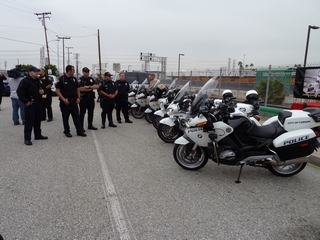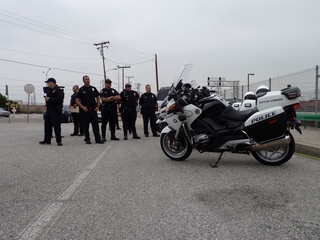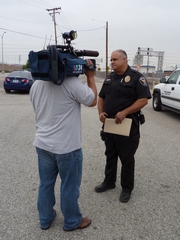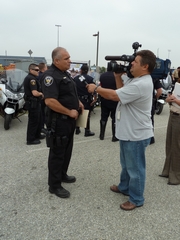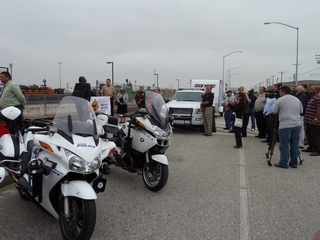Commerce
Station is a lightly used
Metrolink station east of downtown Los Angeles on the BNSF
Railway. Trains do actually stop there. I used to stop by
and watch trains, and, although it seems like a rough, industrial area,
I never had a problem with security or the bad guys. Some
railroaders had been friendly enough to at least engage me in
conversation. The focus of this day's event was really the
trucker. The trucker defined for this event is a human being
truck driver in a large vehicle with as many or more than 18
wheels. A special guest at this event is an Amtrak employee who
was, for many years, an Amtrak engineer working passenger trains in
Florida.
One thing for sure, if the train had been there, it would have been
somewhat quieter. A number of trains, both passenger and freight
flew or rumbled by as the meeting progressed.
The "Trucker-on-the-train" press conference emcee was
Ronnie Garcia from BNSF Railway and also Chairperson for the Southern
California region Rail Safety
Team.in Southern California. Mr. Garcia thanked all who were in
attendance at the first annual Trucker-on-the-Train event and explained
who makes up the Rail Safety Team.. "Basically what our team
consists
of are a few of the freight railroads in the area, some passenger
railroads and some of the state entities. (BNSF Railway, Union
Pacific Railroad, Metrolink, Amtrak, members of law enforcement
agencies, California State Public Utilities Commission and
others.) We get together
monthly, we talk monthly, bi-monthly, about rail safety issues, rail
safety concerns. And we put togther these functions either
monthly or bi-monthly. We go out into the communities And
what we do is we want to promote safety. We want to educate
people. Now today's event, is very special, again, it's our first
one we have ever done." The Rail Safety Team has done many
"Officer-on-a-Train" events in different areas of Southern California.
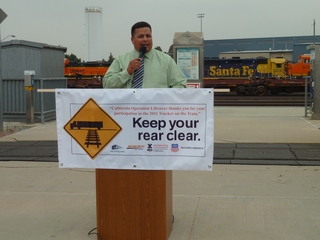
Mr. Garcia then introduced the next speaker, Metrolink Safety
Chief Fred Jackson.
"The most important reason why you
are here today is the relationships
between truck drivers and also trains and train operators. I
speak not on behalf of the locomotive engineers, but through the eyes
of a
locomotive engineer and dispatchers that actually operate our service
throughout the counties we (Metrolink) operate in. There are a
number of near
hits, things we refer to as close encounters, where truck drivers and
other automobiles are actually becoming close encounters and quing up
on the right of way. So hopefully today you use this time
to educate yourself and educate others that these close calls acutally
are all potential incidents that may happen. My job is to analyze
data on the railroad, to use that data, to smartly and
intelligently get the word out to all the other folks on where
our problem areas may be. So through a strategy and enterprise
view, we actually review our incidents and review our data and then we
strategize programs and that's how we came here today, talking aoubt
this event. Truckers are a growing concern for us. We have
a lot of crossings throughout southern California and we have a great
number of truck traffic. So, I encourage all that are here to
share the word and pass the word on. I've networked with a lot of
the safety professionals that are out there and I plan to continue that
relationship. And once again, I do welcome you here. Next,
I'm going intoduce Pete Aadland. Pete is the California Operation
Lifesaver State Coordinator and is a good friend of mine. I've
worked with him for a number of years. And Pete, welcome."
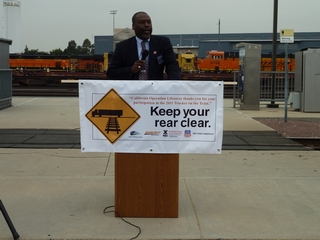
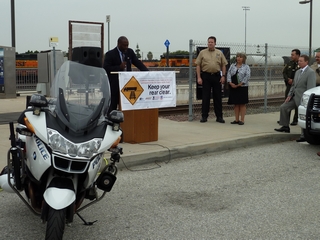
"Ninety five, 95, last year in
California, 95 lives were lost around
railroad property and grade crossings. And the most frustrating
part about what we do and about those 95 lives, 100%, every one of
them, preventable, if only people had obeyed the laws and obeyed the
signs. I'm with California Operation Lifesaver and we are a
nonprofit organization with a mission to completely eliminate those 95,
you know we have a job to do until all injuries and deaths are
completely eliminated. I'm going to give you one more set of
numbers that's kind of appropriate for today. Last year, in
California, there were 124 collisions at grade crossings and that's
where trains and vehicles have the potential to meet. Of
those 124, 11 were tractor trailors and nationally I found this really
hard to believe, the average is somewhere between 20 and 24 percent
depending upon the state of all incidents at grade crossings are
drivers with commmercial drivers licenses. Now these are
significant numbers and even more so when you consider that these
incidents with trucks and trains are much more dangerous for the train
crews and potentially passengers on passenger trains. Obviously
much more hazarderous than anything out there for truck drivers.
They have a much higher potential for community harms and community
impacts and a much higher potential for loss of property. But
with each one of those numbers, there are families, friends, work
colleagues, emergency responders...a whole group of people who you
don't really think about when you look a number on a piece of
paper. And also for every one of those numbers is a train
operator. There is a Billy Parker, who, you will be hearing about
his story shortly. And when you do from his perspective going
through the stories of some of these incidents, it's absolutely
chilling.. We're really fortunate and lucky to have Billy here
today. Today's a very unique event. It's the first one I've
ever heard of in the nation, truckers on the train, to give kind of a
different perspective to the trucking industry, of so much in common
with railroads and the trucking industry of moving freight and goods
throughout our nation. Today's also another special day in that
our national OL is releasing for the first time today a new educational
tool that was designed with the help of the trucking industry
and the railroad industry.
And it's an "e" learning tool and it's called "The Rail Safety
Challenge". Now this is an interactive driving experience where
drivers actually navigate, with their mouse, in real world situations,
and go on several trips with various loads, and different kinds of
railroad grade crossings. And you actually stop your truck and
look both ways. There's all kinds of different scenarios and
signs and stop lines. It's free of charge and can be found at
www.oli.org/. (Click on "PRODRIVER
E-LEARNING" under QUICKLINKS, upper left hand corner of page.) We
will be out and promoting this and look forward
to adding this tool to our toolbox becasue we have volunteers, some of
whom are here today, some of our stalwarts. We do go out and give
free presentations to truck drivers and truck driving companies and
driving schools. So, on behalf of those volunteers, I'd really
like to thank those of you from the trucking industry for participating
today. And a special thanks for our Rail Safety Team, especially
the operational people today... Metrolink, BNSF, UP and Amtrak for
making this all possible. And these railroad partners of ours are
kind of the most pro-active group of anybody that I've seen in the
industry. These organizations are totally focused to using their
resources to get our ahead of incidents and prevent them and not have
to explain them later. So, with that, I had mentioned Billy
Parker and I'm going to hand it over to Mr. Parker. Billy."
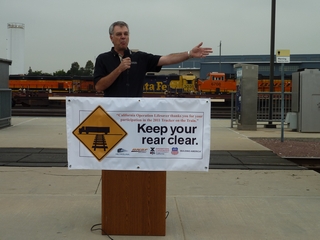
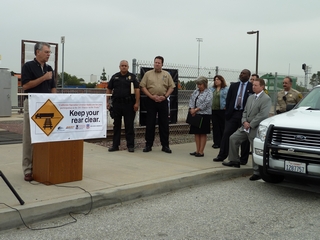
"Thank you Pete and good morning
everyone. My name is Billy
Parker I'm out of Jacksonville Florida with Amtrak as
manager of operating rules. I tell you, I'm proud to be standing
here today for a couple of reasons. Mainly, I look out and I see
people from Metrolink, UP, BNSF, the media, professional truck drivers,
law enforcement officers, volunteers....it's what it's all about.
It's a team effort to prevent grade crossing collisions around this
country and in the State of California. We're very
pleased to have every one of you here today. It's a very
important event that's taken a lot of work by a lot of people. If
I could just say three things and I'm going to hand it over to John
McKuen. There are three things we really preach with OL.
One
is, please, never try to beat a train. It could be the last race
of your life. Two, any time is train time, day or night in any
direction. And three, obviously, trains cannot stop
quickly. We don't have steering wheels up there. So, as we
go forward today as a team effort to prevent these collisions, let's
all see what we can learn. I've been talking to Scott and Josh
from J.B. Hunt a little while ago, and their first comment was "they
can't hardly wait". They're ready to learn something about rail
safety. That's what it's all about. Thank you all for being
here. Let me introduce the vice president for intermodal
operations with J. B. Hunt, Mr. John McKuen. John, great to have
you (here)."
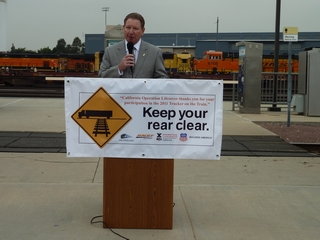
"Once again, I'm John McKuen from
J.B. Hunt. We're happy to be
here. We're talking about railroad safety out here and we take
that very seriously. The two things we want to avoid at all costs
are a collision with a locomotive or a train or a school bus.
Those are the two things that we talk about. But our safety goes
well beyond the right-of-ways of the railroad. We are all over
the state of California and we've got 700 drivers dedicated to
intermodal pickup and delivery in the state. And last year we
were able to move over million loads. A lot of our containers
would come by. That was a milestone that we hit last year.
More importantly, we were able to do it safely. We are always
working to get better and better. But last year we paid out more
in collision and liability claims that we were involved with than the
average civilian would have on his insurance premium paid through an
insurance company. When you think about the amount of miles that
we travel, the length of our equipment, the weight, it's amazing.
And that culminated in, Phil Forden, raise your hand Phil, he actually
achieved his four millionth safe mile last year driving for J. B.
Hunt. Applause. We'll continue to learn more. We
strive at all times to get safer and safer to the public and we
appreciate your time today. Next we have Steve Smith."
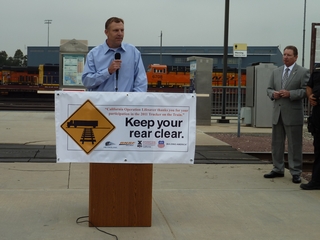
Good morning everybody, I'm Steve
Smith with Metrolink Sheriff. I
am the liason for all the outside agencies with Metrolink that covers
about 513 miles. It's a pretty large area. It has a lot of
things that go on out there. Today's a special day,. This
is
international level crossing awareness day. And what that means
is than not only are we are we doing this here right now, this is
occuring all over the world. And I've been asked the question
some
times....(A Metrolink train runs behind the speaker.) How
appropriate, any time is train time. But I've been asked the
question sometimes, "how often do we do this kind of operation?
Do we do it once a year, twice a year?" We do this operation all
over the United States all the time. When you think about and
this kind of a sobering fact, every 180 minutes, there is some type of
incident going on. In the few hours that we have been here this
morning, we've taken several violations. One of those violations,
if you can believe this, was a pedestrian, walking underneath a
crossing gate. And when the officer contacted him on the other
side, it was kind of an interesting contact. This person had a
loaded gun on him. Kind of scary isn't it? But there's
always something going on, so you have to ask yourself "why did this
person cross underneath that gate when he could have been hit by a
train?" I guess he felt like he was lucky. But we want to
prevent these types of situations going on out here. We want to
prevent cars from stopping on the tracks. This morning we're
working with several agencies, over 40 officers with a specialized
task force out there. And our commitment is safety to reduce
those incidents, to get them down. Nothing is acceptible above
zero. We've all probably known somebody that had some type of
collision. We want to prevent that today. So, my mission is
to keep that safety, do things right, by education, enforcement
and engineering. And I appreciate everybody joining me out here
to make this possible. The trucking association...good
partnership. OK I'm going to turn it over to Senior Agent Jorge
Villaescusa, Union Pacific Railroad. Jorge.."
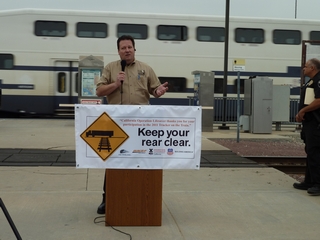
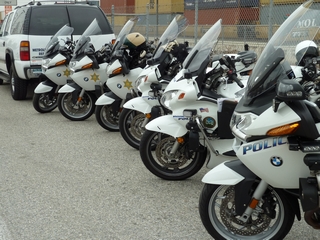
"Thank you Steve. My name is
Jorge
Villaescusa, Police Officer with the Union Pacific Railroad. I'm
just going to talk to you about the two phase operation we have going
this morning and afternoon. This morning, we are doing
enforcement east of this location all the way through Santa Fe Springs,
Norwalk and basically emphasizing all crossings that vehicles should
stop when the gates activate. Pedestrians should wait as
well. We're going to run this operation through about 11:00 this
morning then we're going move in the afternoon at 3:00 to the City of
Industry at which time we are going to work from 3:00 PM to about 7:00
PM. We're going to hit all the crossings there off of Fairway,
Nogales and Fullerton Road. Again, it's very busy intersections
out there, we get a lot of gridlock. One of our main issues that
we have is that vehicles stop on the tracks. A lot of times we
have truck drivers that stop on the tracks and unfortunately we have
what is called short stage crossings where the truckers don't have the
room coming in. (In a separate interview with Jorge Villaescusa,
he explained a short stage crossing. It is illustrated by
imagining a "T" intersection with a parallel railroad track just under
the top horizontal line of the "T". When the truck pulls up to the
intersection with a stop sign, the truck may be on the track. The
railroad may ask the responsible public entity to change the stop sign
to a signal. This change helps the trucker and trains stay safe
and separate. He suggested to view the City of Industry street
intersection of Valley Blvd and Fullerton Road.) When that
happens and the gates activate, you have the
gridlock going on, a lot of times the train is going to hit the truck
or it's going to be close enough or there's going to be other accidents
involved. I want to thank, first of all, all the law enforcement
agencies that came out here to help us out today. I want to thank
the trucking companies that came out here. That tells us a lot
that they want to take the message back on safety with the
crossings. I'll tell you right now that I would rather give
someone a citation and see them in court rather than come out here and
respond to a fatality report and have to see them somewhere else.
I want to thank you all for being out here and we'll keep you updated
with the numbers. Later on we'll be briefing. Next, we'll
have Ronnie Garcia from BNSF." Mr. Garcia explained the boarding
plan for the train which was to arrive shortly.
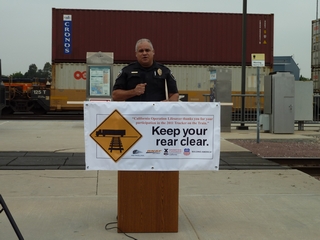
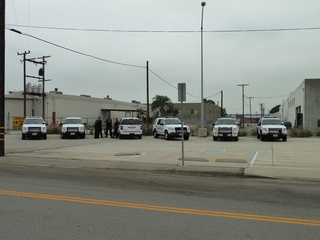
The train was slightly delayed so the
Rail Safety Team decided to ask
Billy Parker to speak a second time. Billy Parker spoke for
another 17
minutes and went into detail about a certain incident from 1993 in
Florida. He was the engineer on an Amtrak train which was
involved
with a load gasoline tanker truck which resulted in deaths of innocent
motorists. It is the most passionate story you might ever hear of
a
train versus truck incident. You may view and hear the whole
speech
via youTube. It is broken into two parts.
Part One is
about 7 minutes
while
Part Two
is 10 minutes. If you have not ever heard this story or are
unfamiliar with it, please watch this video. It may change your
life.











